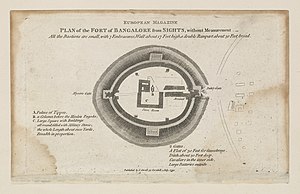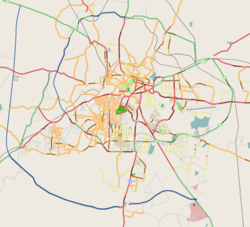| Bangalore Fort | |
|---|---|
| Part of Bangalore District | |
| Karnataka, India | |
 Bangalore Fort | |
 Plan of Bangalore Fort, 1792 | |
| Coordinates | 12°57′46″N 77°34′33″E / 12.962875°N 77.575956°E |
| Type | Fort |
| Site information | |
| Controlled by | Archaeological Survey of India |
| Open to the public | Yes |
| Condition | Fair |
| Site history | |
| Built | 1537 |
| Built by | Kempegowda I |
| Materials | built in 1751 CE with granite stones south of 2 centuries old mud fort |
Bangalore Fort began in 1537 as a mud fort.[1] The builder was Kempe Gowda I, a vassal of the Vijaynagar Empire and the founder of Bangalore. King Hyder Ali in 1761 replaced the mud fort with a stone fort and it was further improved by his son King Tipu Sultan in the late 18th century. It was damaged during an Anglo-Mysore war in 1791. It still remains a good example of 18th-century military fortification. The army of the British East India Company, led by Lord Cornwallis on 21 March 1791 captured the fort in the siege of Bangalore during the Third Mysore War (1790–1792). At the time the fort was a stronghold for King Tipu Sultan. Today, the fort's Delhi gate, on Krishnarajendra Road, and two bastions are the primary remains of the fort. A marble plaque commemorates the spot where the British breached fort's wall, leading to its capture. The old fort area also includes King Tipu Sultan's Summer Palace, and his armoury. The fort has provided the setting for the treasure hunt in the book Riddle of the Seventh Stone.[2]
- ^ Packe, Cathy (4 November 2006). "48 HOURS IN BANGALORE; New flights make it easier to explore the elaborate architecture and spice markets of this buzzing Indian city". The Independent. Archived from the original on 25 January 2013. Retrieved 2 September 2012.
- ^ Madhukar, Jayanthi (18 October 2010). "Into B'lore's underbelly". Bangalore Mirror. Archived from the original on 7 October 2011. Retrieved 29 May 2012.
